The Friends of the Wildflower Garden, Inc.
Plants of the Eloise Butler Wildflower Garden
The oldest public wildflower garden in the United States

Common Name
Marsh Marigold (Yellow Marsh Marigold, Cowslip; King's Cup)
Scientific Name
Caltha palustris L.
Plant Family
Buttercup (Ranunculaceae)
Garden Location
Wetland
Prime Season
Spring
Marsh Marigold is found throughout the wetland area of the Woodland Garden. It is one of the first splashes of green to show in the wetland, followed by the brilliant yellow flowers that resemble giant buttercups. Marsh Marigold is a native erect perennial forb growing from from 8 to 24 inches high. Stems are hollow and branch near the top. With age they may sprawl and produce roots or shoots at the stem nodes.
The leaves are both basal and stem, heart shaped with shallow teeth or smooth edges, and not divided; basal leaves grow on long stalks, stem leaves are alternate and on short stalks. The upper surface is a medium green, sometimes showing a prominent reddish tinted vein pattern while the underside is much paler due to soft fine hair. The leaves are somewhat toxic.
The inflorescence is short stalked cluster of 1 to 7 stalked flowers rising from the upper stem leaf axils.
The flowers are 1 to 1-1/2 inches across, have no real corolla, but have from 5 to 9 (sometimes to 12) sepals (no petals) that are a beautiful yellow. The sepals are broadly oval, overlapping, with prominent veins for nectar guides, and fall away during fruiting. Stamens number 10 to 40, with yellow filaments and anthers. Pistils number 5 to 15. Flowers persist for an extended period while the bogs and marshes green-up.
Seed: Fertile flowers produce 5 to 15 seed follicles that are ellipsoid in shape with a straight or curved beak at the tip, spreading outward from a central point, without stalks. Each follicle contains a small number of individual seeds that are elliptical in shape. Seeds require at least 60 days of cold stratification for germination.
Toxicity: See notes at bottom of page.
Habitat: Marsh Marigold grows from a fibrous root system with a thick caudex. Stems can root at the nodes and it can re-seed. It is a plant of moist soils, wet meadows, marshes, bogs but not in standing water for any length of time during the growth period. Full sun for fine bloom. The plant can sometimes have a re-bloom in the autumn.
Names: The genus name Caltha was a Latin name for Marigold, derived from the Greek calathos, meaning a cup or goblet and referring to the flower shape. The species name palustris, means "of the swamp or marshes" - a plant of wet places. The name of the author of the plant classification from 1753 - 'L.', is for Carl Linnaeus (1707-1778), Swedish botanist and the developer of the binomial nomenclature of modern taxonomy. Eloise Butler explains (at the bottom of the page) the mis-application of the Cowslip name.
Comparisons: While the genus is closely related to the Buttercups, these flowers are larger and bloom much earlier than most Buttercups. Other species of Caltha are located in other parts of the U.S. and many have white flowers as does the only other Minnesota species, C. natans, Floating Marsh Marigold. Eloise Butler's notes on this plant are given below.

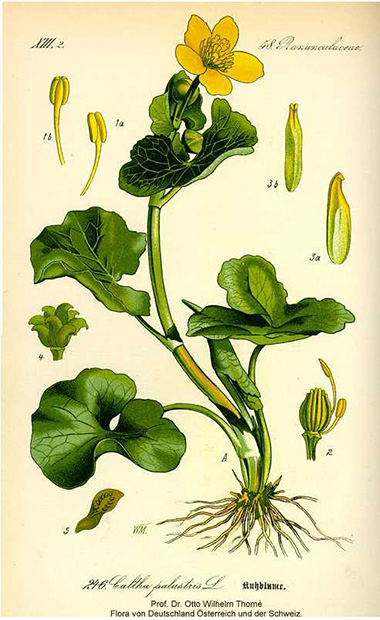
Above: Marsh Marigold showing both stem and basal leaves, the basal with serrate edges. Drawing of Marsh Marigold courtesy Kurt Stüber's Online Library.
Below: The flowers have yellow sepals, no petals. The numerous yellow stamens surround a group of yellow-green pistils of the multi-carpel ovary.
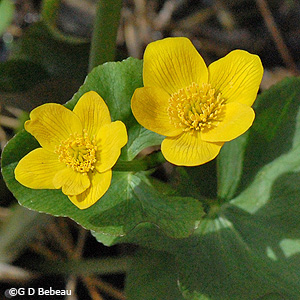
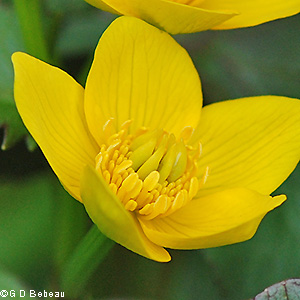
Below: 1st photo - Young emerging leaves have a greenish-bronze color. 2nd photo - A mature basal leaf with its long stalk.
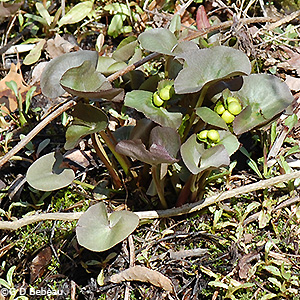
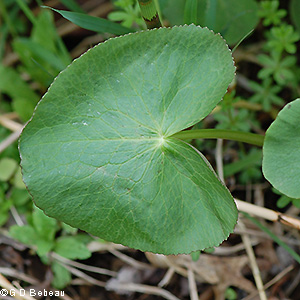
Below: 1st photo - Some leaves can show a reddish vein pattern and some have margins that are fairly smooth or can have small teeth like the example above. 2nd photo - Lacking a corolla, the flower has a number of yellow overlapping sepals that maintain a tinge of green on the outside.
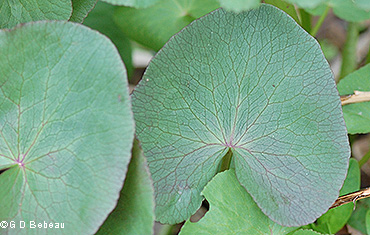
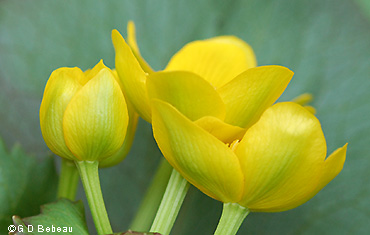
Below: 1st photo - The underside of the leaf shows the networked vein pattern quite plainly. This surface is very pale in color due to soft whitish hair. 2nd photo - An unusual specimen showing white tips on the sepals.
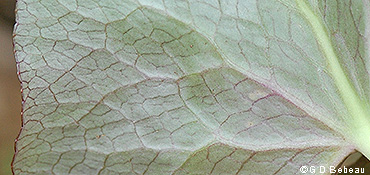

Below: 1st photo - A seed head with 6 follicles formed at the end of May. Each fertile carpel produces a seed follicle. 2nd photo - 13 follicles with mature seeds
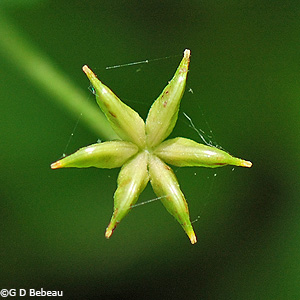

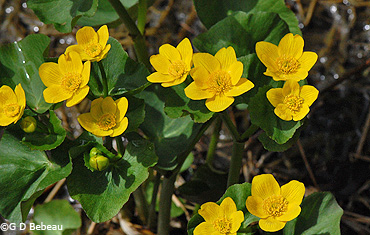
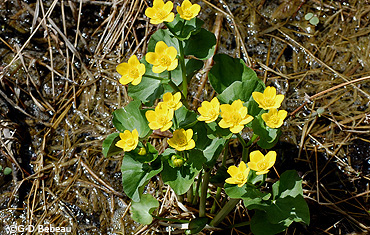

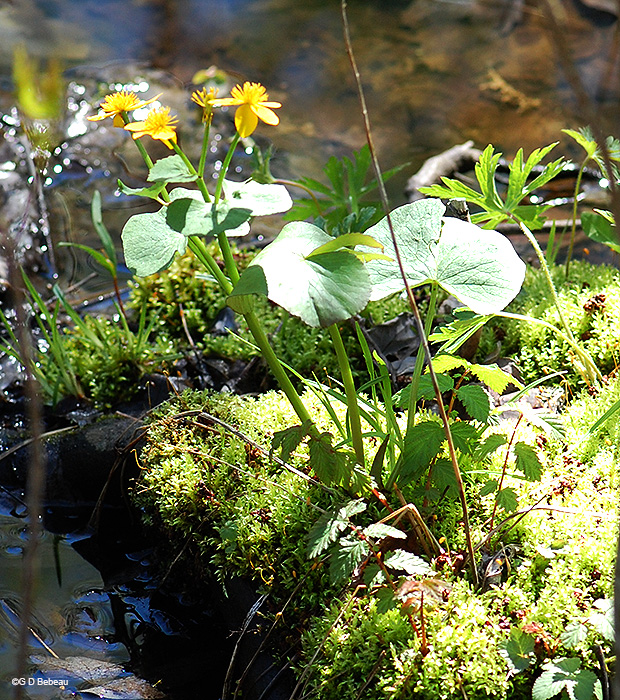
Notes: Marsh Marigold is indigenous to the Garden area. Eloise Butler first reported seeing this on May 25, 1907 and then on Nov. 3, 1908 noted one of the rare late fall blooms. There are no records of any curator having to replant it. The plant is native to most counties in Minnesota except those in the drier SW corner. In North America it is known throughout Canada, down along the west coast, absent in the Rocky Mountain states and then found in the eastern part of the U.S. from the Dakotas and Nebraska eastward to the coast and south as far as Tennessee and North Carolina.
There are two species of Caltha found in Minnesota: C. palustris, Marsh Marigold; and C. natans, Floating Marsh Marigold. The latter is known only from St. Louis County and is on the State Endangered Species List.
Eloise Butler wrote of this plant: "Now is the time that we are enticed to buy from children on the streets big bunches of the cheerful Marsh Marigold. For she always sits with her feet - roots - in the water, and only barefooted boys are likely to reach her, although “Enough for everybody and to spare” is her motto. The plant is wrongly called “cowslip.” The true cowslip is a European primrose and resembles the marsh marigold only in color. Wordsworth’s Peter Bell would have stopped to pick the young leaves of the marsh marigold for greens - something more substantial than mere yellow flowers. Both the marsh marigold and the primrose are familiar flowers in Europe, and both are named in Jean Ingelow’s “Songs of Seven.” (Published in the Sunday Minneapolis Tribune, May 7, 1911)
Toxicity & Lore: Mrs. Grieve (Ref. #7) reports that the English name Marigold refers to its use in church festivals in the Middle Ages as one of the flowers devoted to Mary. Shakespeare refers to the flower several times. Every part of the plant is an irritant. The raw leaves contain helleborin, which has a burning taste and is toxic, causing violent gastritis if eaten. This chemical can be removed by twice boiling.
Return to -- Site Plan/Archive Index --or-- List of Common Plant Names -- or -- List of Scientific Names -- or --Home Page - - - Back to top.
References: Plant characteristics are generally from sources 1A, 32, W2, W3, W7 & W8 plus others as specifically applied. Distribution principally from W1, W2 and 28C. Planting history generally from 1, 4 & 4a. Other sources by specific reference. See Reference List for details.
 Identification booklet for most of the flowering forbs and small flowering shrubs of the Eloise Butler Wildflower Garden. Details Here.
Identification booklet for most of the flowering forbs and small flowering shrubs of the Eloise Butler Wildflower Garden. Details Here.
©2014
Friends of the Wildflower Garden, Inc. Text and photos are by G. D. Bebeau unless otherwise credited. "www.friendsofeloisebutler.org"
070820